Easy DIY Guitar Pedal Builds
For those who are just getting started building their own guitar pedals at home, it’s usually best to not just jump in with something too hard. There are some great pedals out there and, although you probably want to jump in and make your favourite pedal or make something that’s hard to find, it may be beyond your skill level. If you try to make something too hard, you may get discouraged from pursuing this awesome hobby and never work your way up to what inspired you in the first place.
So start with something easy…
This page is/will be an ever growing list of easy/beginner DIY guitar pedals. As I find them, I’ll list them here. Where possible, I’ll link to a resource on how to make it and, when if I’ve built one, I’ll link to the build report for you to follow along with.
Heads up in advance, these easy to make guitar pedals are pretty much all boost, fuzz, or distortion. These circuits tend to be a lot simpler and have a lot few parts, so they’re good to start on.
If you’re looking for more DIY pedal builds, check out all of my guitar pedal stripboard layouts. It’s an ever growing list.
What Makes An Easy To Make Guitar Pedal?
Generally, an easy to make DIY guitar pedal has fewer parts. Fewer parts means there are fewer places to make mistakes. And when you’re first getting started, you’re more likely to make mistakes.
When you do make a mistake with a new pedal build, something with fewer parts will also be easier to troubleshoot.
All in all, pick something with fewer parts and with a layout that isn’t too compact.
Not Even Sure Where To Start?
That’s OK. The builds listed below are written for people who already know how to follow a stripboard layout. If that’s not you, I also have a guide on how to build your first distortion pedal. It’s a bit more of a step by step guide on everything you need to do to make a guitar pedal at home. It’s not that hard, but figuring out the first steps can be a bit daunting, so I’ve outlined it for you and linked to relevant resources!
Easy DIY Guitar Pedals Table Of Contents
Saving you from scrolling to jump straight to the info on these easy to make guitar pedals.
Boost
Fuzz
- DAM Meathead
- Escobedo Harmonic Jerculator
- Fuzz Face
- Seven Minute Fuzz
- Vox Tone Bender
- Colorsound 1 Knob Fuzz
Distortion
- EarthQuaker Devices Acapulco Gold
- EarthQuaker Devices Speaker Cranker
- Greer Amps Green Giant
- Love Pedals Purple Plexi
Overdrive
Easy To Make Boost Pedals
Catalinbread Naga Viper Treble Boost
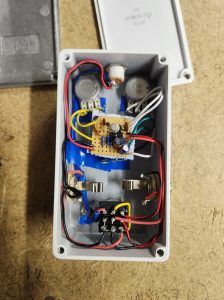 Based on the Dallas Rangemaster from the 1960’s, the Naga Viper by Catalinabread is a great little boost pedal. Use this pedal with dirty setting of your amp to eliminate some of the mud created pushing it too hard, or experiment with where to put it in your signal chain for vastly different results.
Based on the Dallas Rangemaster from the 1960’s, the Naga Viper by Catalinabread is a great little boost pedal. Use this pedal with dirty setting of your amp to eliminate some of the mud created pushing it too hard, or experiment with where to put it in your signal chain for vastly different results.
The Naga Viper can be used as an “always on” style pedal to give a specific, consistent tone; or use it for solos to break through the mix and give a bit more volume.
Here’s the Catalinbread Naga Viper stripboard layout.
Echoplex EP3 Preamp
Here’s another boost pedal that does what it says on the tin: it acts as a preamp, boosting your guitar signal, giving it some volume and tone similar to the preamp of an Echoplex EP3.
All in all, this pedal gives pretty clean gain with only the faintest hint of clipping giving a more organic and tube-like sound to a generic solid state amp. Having a pedal like this in your line up is a great way to make an amp sound a whole lot nicer.
Tag Board effects has a few EP3 layouts that you may enjoy building. The third layout with the volume control looks to be best for beginners.
ZVEX Super Hard On
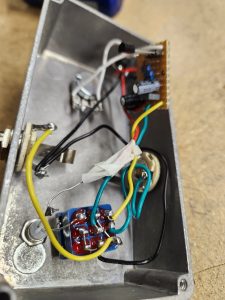 The Super Hard On, or SHO, is a transparent boost pedal that adds more volume to the guitar signal without affecting the tone. On the higher end of things and, depending on the amp, a little bit of clipping comes through, but, like so many boost pedals, this gives a sound and tone that’s similar to a vintage tube amp.
The Super Hard On, or SHO, is a transparent boost pedal that adds more volume to the guitar signal without affecting the tone. On the higher end of things and, depending on the amp, a little bit of clipping comes through, but, like so many boost pedals, this gives a sound and tone that’s similar to a vintage tube amp.
I’ve made on of these pedals myself and like to just use it as “always on” when I’m running an otherwise clean guitar sound. It makes the guitar sound a bit more organic and satisfying. You don’t need much though, otherwise things get loud real quick!
Check out how to make a SHO on stripboard.
Easy To Make Fuzz Pedals
DAM Meathead
The DAM Meathead is a basic and raw fuzz pedal. With only one knob for overall dirt, you can still get a lot of sounds out of it.
The Meathead only has 15 components, including the single potentiometer, and, even more compact layouts I’ve seen, isn’t so crowded that it makes it difficult.
Fuzz pedals are a lot of fun to use, but also very simple to build, so they’re a great place to start your DIY pedal journey.
Tag Board Effects has two layouts that you can try, depending on how you like to do things.
Escobedo Harmonic Jerculator
 The Harmonic Jerculator is a two knob fuzz pedal that is a variation on the classic Interfax Harmonic Percolator. You can’t get the Harmonic Percolator anymore, and the parts can be hard to come by, so the Jerculator is an attempt to make something similar with modern parts. And it does it very well!
The Harmonic Jerculator is a two knob fuzz pedal that is a variation on the classic Interfax Harmonic Percolator. You can’t get the Harmonic Percolator anymore, and the parts can be hard to come by, so the Jerculator is an attempt to make something similar with modern parts. And it does it very well!
If you’re after a classic fuzz sound that’s also fairly stripped back, this is the pedal for you.
I’ve built one of these, so take a look at the Harmonic Jerculator schematic and stripboard layout in my build report.
Fuzz Face
The Fuzz Face is a classic fuzz box that’s been used by countless artists to bring about some pretty famous rock tones over the years.
The biggest challenge with the Fuzz Face is that it was originally built with Russian made geranium transistors. Even if you can find them, they’re known to be fairly unreliable. With that, the original layout isn’t made for the more modern power paradigms found in most guitar pedals, so you may have trouble simply swapping out the transistors.
There are loads of silicon Fuzz Face schematics out there, with different variations on the sound. I’d encourage you to do some larger research into the specific variations of the Fuzz Face to find the exact tone you’re after.
Seven Minute Fuzz
“Does what it says on the tin” seems to be the saying of this page, because here’s another DIY guitar pedal that’s exactly what it sounds like. It’s a quick and easy to make fuzz pedal that you can complete in under 10 minutes.
This is a basic one knob fuzz box that still sounds great even though it’s basic!
The Seven Minute Fuzz is available as a PCB from a variety of suppliers and often available as a standalone kit that comes with all the parts that you’ll need to make the pedal, so you shouldn’t have any trouble here!
Vox Tone Bender
 Here’s a nice and easy two knob fuzz pedal that’s pretty easy to make: the Vox Tone Bender. This is one of the earlier fuzz pedals out there and great for some classic sounds.
Here’s a nice and easy two knob fuzz pedal that’s pretty easy to make: the Vox Tone Bender. This is one of the earlier fuzz pedals out there and great for some classic sounds.
While a lot of the easier to build/beginner friendly DIY guitar pedals out there are single knob (especially when it comes to fuzz), it’s great to see an easier to make pedal that has two knobs: an attack (AKA fuzz) and level (AKA volume).
You can check out my Tone Bender build, I’m quite happy with how it turned out. The build report uses Tagboard Effects’ layout as well as the schematic if you want to fool around with it.
Colorsound One Knob Fuzz
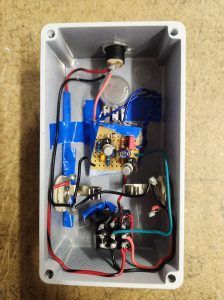 Time for that saying again: it does what it says on the tin. Here’s a fuzz pedal with only one knob. And because of that, it’s pretty easy to make!
Time for that saying again: it does what it says on the tin. Here’s a fuzz pedal with only one knob. And because of that, it’s pretty easy to make!
Colorsound have some great simple pedal builds out there, and the One Knob Fuzz is probably one of their easiest. From the build, the One Knob Fuzz from Colorsound looks to be very similar to the Meathead (listed earlier). This gives you the choice to make both and get some slightly different fuzz sounds. Then decide which one you like more and give the other to a friend.
Easy To Make Distortion Pedals
EarthQuaker Devices Acapulco Gold
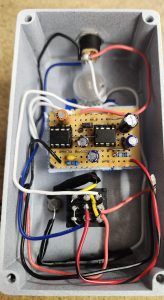 Single knob distortion, that’s what the Acapulco Gold is!
Single knob distortion, that’s what the Acapulco Gold is!
This pedal is a super simple way to get some gritty distortion into your sound. All this pedal has is one knob that adjust the volume; you can control how much distortion there is by adjusting the volume on your guitar. Tone is controlled through your guitar as well. It’s just supposed to sound like an old amp that’s trying way too hard to not destroy itself.
Watch out, because the Acapulco Gold gets loud real quick.
Check out the build for the Acapulco Gold. It’s not very crowded, which makes it easier.
EarthQuaker Devices Speaker Cranker
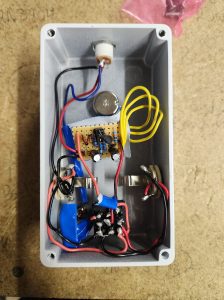 Here’s another single knob distortion from EarthQuaker Devices. It’s not as bit a distortion as some, and a bit more of an overdrive in a lot of ways, but it still sounds great!
Here’s another single knob distortion from EarthQuaker Devices. It’s not as bit a distortion as some, and a bit more of an overdrive in a lot of ways, but it still sounds great!
Have a go at this DIY pedal if you’re looking for something easy. It’s based on the Electra Distortion circuit, so if you’ve built one of those before, you should have no problem building the Speaker Cranker. But even if you haven’t built a pedal before, you should have no problem building this one.
Have fun.
Here’s how to build a Speaker Cranker.
Greer Amps Green Giant
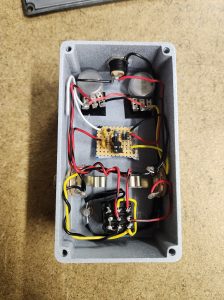 This is a super cool distortion pedal that’s also very easy to make.
This is a super cool distortion pedal that’s also very easy to make.
Based on the Electra Distortion circuit, the Green Gaint by Greer Amps, the unique thing about the Green Giant is that it’s set up to mix distorted and clean signals. This creates a situation where sounds are layered and complex. It’s a truly unique distortion sound.
With all of that, the Green Giant gives a relatively smooth distortion sound suitable to Blues, Country, and straight Rock. If you’re looking for some heavy crunch, you’re in the wrong place. But if you’re looking for something different, Greer Amps’ Green Giant is a good choice.
Check out the Green Giant stripboard layout.
Lovepedal Purple Plexi
 If you’re looking for the sound of a vintage Marshall amp cranked to 11, the Purple Plexi is the way to go.
If you’re looking for the sound of a vintage Marshall amp cranked to 11, the Purple Plexi is the way to go.
The Purple Plexi has three knobs to it (gain, tone, and volume), so it’s a nice and easy to build guitar pedal that also has a full range of control you’d expect from a modern pedal.
I wouldn’t suggest making this your first pedal build, but you should be fine making it as your third or fourth.
Here’s my Purple Plexi build and stripboard layout.
Which One Did You Build?
Hopefully you’ve found one or two guitar pedals here that both suit your interest and you find simple enough to be a beginner build. Or maybe you have some experience building guitar pedals yourself and you’re just looking for an easier build to relax with.
Half the point of this website is to encourage other people to take up the hobby of building their own guitar pedals, so finding accessible builds for beginners is something I want to continue to work on. Check back often for updates.
